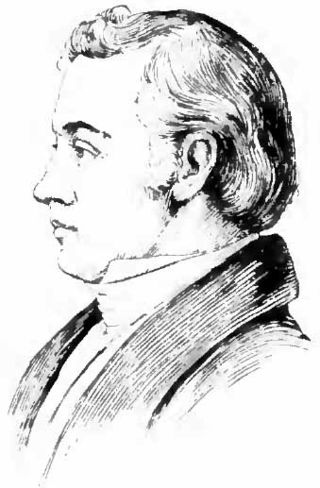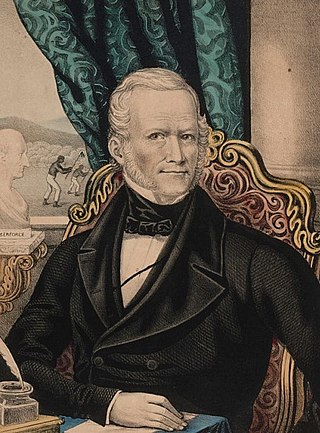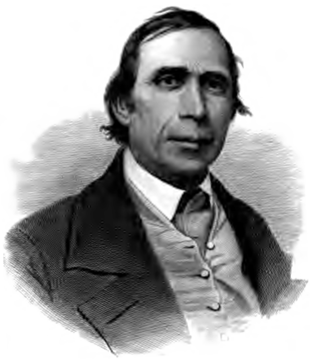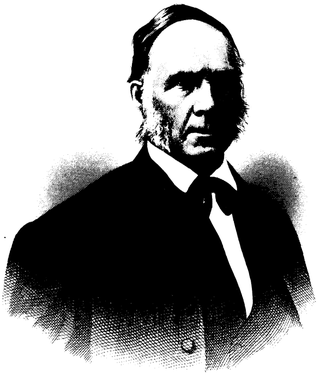Related Research Articles

Theodore Dwight Weld was one of the architects of the American abolitionist movement during its formative years from 1830 to 1844, playing a role as writer, editor, speaker, and organizer. He is best known for his co-authorship of the authoritative compendium American Slavery as It Is: Testimony of a Thousand Witnesses, published in 1839. Harriet Beecher Stowe partly based Uncle Tom’s Cabin on Weld's text; the latter is regarded as second only to the former in its influence on the antislavery movement. Weld remained dedicated to the abolitionist movement until slavery was ended by the Thirteenth Amendment to the United States Constitution in 1865.

Elijah Parish Lovejoy was an American Presbyterian minister, journalist, newspaper editor, and abolitionist. After his murder by a mob, he became a martyr to the abolitionist cause opposing slavery in the United States. He was also hailed as a defender of free speech and freedom of the press.

James Gillespie Birney was an American abolitionist, politician, and attorney born in Danville, Kentucky. He changed from being a planter and slave owner to abolitionism, publishing the abolitionist weekly The Philanthropist. He twice served as the presidential nominee for the anti-slavery Liberty Party.
The Genius of Universal Emancipation was an abolitionist newspaper founded by Benjamin Lundy in 1821, in Mount Pleasant, Ohio.

The North Star was a nineteenth-century anti-slavery newspaper published from the Talman Building in Rochester, New York, by abolitionist Frederick Douglass. The paper commenced publication on December 3, 1847, and ceased as The North Star in June 1851, when it merged with Gerrit Smith's Liberty Party Paper to form Frederick Douglass' Paper. At the time of the Civil War, it was Douglass' Monthly.

Abby Kelley Foster was an American abolitionist and radical social reformer active from the 1830s to 1870s. She became a fundraiser, lecturer and committee organizer for the influential American Anti-Slavery Society, where she worked closely with William Lloyd Garrison and other radicals. She married fellow abolitionist and lecturer Stephen Symonds Foster, and they both worked for equal rights for women and for Africans enslaved in the Americas.

Jonathan Walker, known as "The Man with the Branded Hand", was an American reformer who became a national hero in 1844 when he was tried and sentenced as a slave stealer following his attempt to help seven runaway slaves find freedom. He was branded on his hand by the United States Government with the markings "S S", for "Slave Stealer".

Erastus Hussey (1800–1889) was a leading abolitionist, a stationmaster on the Underground Railroad, and one of the founders of the Republican Party. He supported himself and his family as a farmer, teacher, businessman, legislator, and editor.

The Philanthropist was an abolitionist newspaper printed in Cincinnati, Ohio, starting in 1836, edited by James G. Birney, and printed Achilles Pugh for the Ohio Anti-Slavery Society. Originally published at New Richmond, Ohio due to complications with Cincinnati mayor Samuel W. Davies, the paper moved to Cincinnati in April 1836 to resume publication. The plan had always involved Cincinnati, but Birney wanted to publish a few issues out of the jurisdiction of Davies first. The paper often gave readers two sides of an argument, printing news items from the South that were proslavery and then critique them.
The first Anti-Slavery Convention of American Women was held in New York City on May 9–12, 1837 to discuss the American abolition movement. This gathering represented the first time that women from such a broad geographic area met with the common purpose of promoting the anti-slavery cause among women, and it also was likely the first major convention where women discussed women's rights. Some prominent women went on to be vocal members of the Women's Suffrage Movement, including Lucretia Mott, the Grimké sisters, and Lydia Maria Child. After the first convention in 1837, there were also conventions in 1838 and 1839
The Liberty Party was an abolitionist political party in the United States prior to the American Civil War. The party experienced its greatest activity during the 1840s, while remnants persisted as late as 1860. It supported James G. Birney in the presidential elections of 1840 and 1844. Other prominent figures connected with the Liberty Party included Gerrit Smith, Salmon P. Chase, Henry Highland Garnet, Henry Bibb, and William Goodell. The attempted to work within the federal system created by the United States Constitution to diminish the political influence of the Slave Power and advance the cause of universal emancipation and an integrated, egalitarian society.
Stephen Symonds Foster was a radical American abolitionist known for his dramatic and aggressive style of public speaking, and for his stance against those in the church who failed to fight slavery. His marriage to Abby Kelley brought his energetic activism to bear on women's rights. He spoke out for temperance, and agitated against any government, including his own, that would condone slavery.
The Emancipator (1833–1850) was an American abolitionist newspaper, at first published in New York City and later in Boston. It was founded as the official newspaper of the American Anti-Slavery Society (AASS). From 1840 to 1850, it was published by the Liberty Party; the publication changed names several times as it merged with other abolitionist newspapers in Boston.

The Boston Female Anti-Slavery Society (1833–1840) was an abolitionist, interracial organization in Boston, Massachusetts, in the mid-19th century. "During its brief history ... it orchestrated three national women's conventions, organized a multistate petition campaign, sued southerners who brought slaves into Boston, and sponsored elaborate, profitable fundraisers."
The History of slavery in Michigan includes the pro-slavery and anti-slavery efforts of the state's residents prior to the ratification of the Thirteenth Amendment to the United States Constitution in 1865.

Sarah (Sallie) Holley served as an educator to African Americans during the mid-1800s, becoming an avid member of the American Anti-Slavery Society. Specifically, Holley worked closely with Caroline Putnam to establish the Holley School, which still stands today.
The Ohio Anti-Slavery Society (1835-1845) was an abolitionist Anti-Slavery Society established in Zanesville, Ohio, by American activists such as Gamaliel Bailey, Asa Mahan, John Rankin, Charles Finney and Theordore Dwight Weld.
Guy Beckley (1803–1847) was a Methodist Episcopal minister, abolitionist, Underground Railroad stationmaster, and lecturer. The Guy Beckley House is on the National Park Service Underground Railroad Network to Freedom and the Journey to Freedom tour. It stands next to Beckley Park, which was named after him.
The Michigan Anti-Slavery Society, also called Michigan State Anti-Slavery Society was founded on November 10, 1836, in Ann Arbor of the Michigan Territory (1805–1837). The first meeting was held at the First Presbyterian Church on East Huron Street. The founding of the anti-slavery society was part of a movement to abolish slavery in several states during the 1830s, as well as support within the territory for the Underground Railroad.

Marius Robinson (1806–1878) was an American minister, abolitionist, and newspaper editor of the antislavery newspaper The Philanthropist and The Anti-Slavery Bugle. He helped establish a school for African Americans in Cincinnati, Ohio while attending Lane Seminary. Responding to backlash from the city's residents, he continued to teach and was one of the Lane Rebels who would not be pressured to give up improving the lives of African Americans. He was an anti-slavery lecturer. He worked together with his wife Emily Rakestraw Robinson, to better the lives of African Americans.
References
- 1 2 3 4 5 6 Mull, Carol E. "Signal of Liberty". Ann Arbor District Library. Retrieved 2022-03-30.
- ↑ "Browse the Signal of Liberty & Michigan Liberty Press". Ann Arbor District Library. Retrieved 2022-03-30.